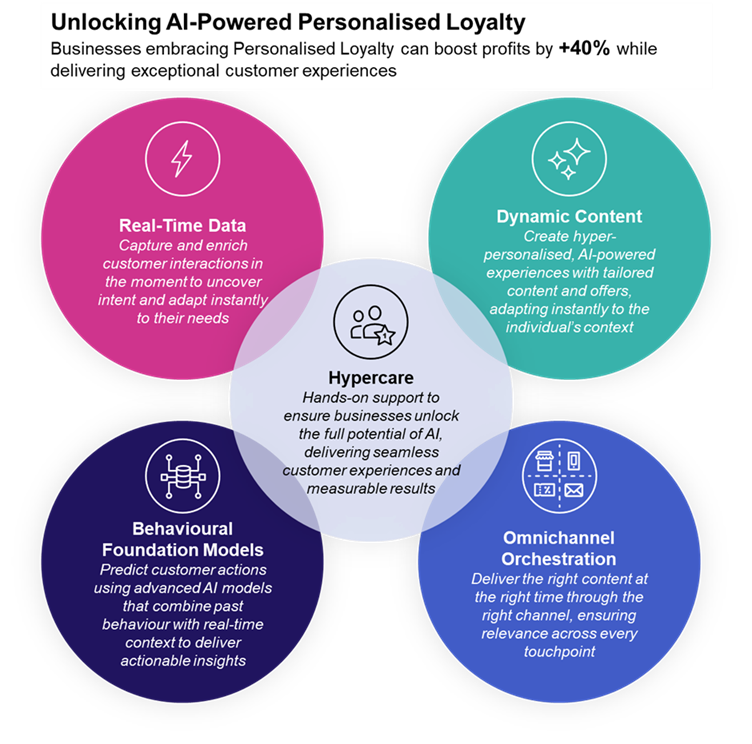AI-powered, personalised loyalty: the next frontier in the pursuit of customer relevance
Retailers, telcos, banks, and beyond. Today, every consumer-focused company—regardless of industry—is facing a world in which customers are more selective than ever about where they spend their money. With rising prices, higher bills, and increased borrowing costs, businesses are having to work harder and harder in order to stay relevant and earn the loyalty of their customers.
At the same time, advances in data science, cloud infrastructure, and software are creating brand new ways to engage customers. Companies that use these tools aren’t just delivering greater value to customers, but improving their own financial performance, too. In fact, as we explained in our recent whitepaper, Artificial Intelligence (AI)-powered personalised loyalty can help organisations boost their profitability by more than 40%.
Loyalty has always been about building relationships, but the game has changed. To win today, loyalty must be personal. Personalisation is the key to engaging customers at an individual level, and AI is the engine that makes it possible. With AI, companies can harness vast amounts of data to deliver tailored offers, relevant rewards and timely communications that feel truly personal.
This shift to AI-powered, personalised loyalty marks the next evolution in customer engagement. But to unlock that potential, and to thrive in this new era, businesses need to develop five key capabilities.

- Real-time event handling
Capturing longitudinal and real-time customer events, enriched with contextual data to create a segment of one"We are what we do," or so the old adage goes. But in today’s world of advanced data science, it goes beyond that. We are, also, “what we think” and “what we feel”. And sometimes, we’re just not sure. Understanding customers isn’t just about their actions, but their intent in the moment. Companies need to capture every customer interaction as it happens, and enrich this data with contextual insights to form a complete, real-time view of the individual.
This means tracking everything from webpage visits and physical movements through to local weather patterns and purchase histories. By connecting these data points in real time, businesses can infer intent and adapt to customer needs instantly. Food delivery platforms like Deliveroo or Uber Eats could offer free delivery during a rainstorm, for instance, allowing families to enjoy their dinner without heading out in bad weather.
Real time event handling enables businesses to serve customers better by acting on insights as they emerge, one moment at a time.
- Behavioural foundation models
Predicting customer behaviour with in-the-moment contextThe evolution of AI has come in waves, the most recent being Generative AI (GenAI). At the heart of this latest shift is a broader trend: the emergence of generalised foundation models. These excel at sifting complex, unstructured data and creating accurate predictions, making them a natural fit for the new era of personalised loyalty.
Behavioural foundation models enable companies to predict what customers will do next based not just on past actions, but the in-the-moment context, too. Leveraging self-supervised techniques, these models eliminate the need for manual labelling and use graph-based methods to distil complex customer interactions into meaningful representations of intent.
Ultimately, this transforms mountains of unstructured data into actionable insights. More specifically, it empowers businesses to deliver timely, relevant, and highly personalised recommendations. In the age of personalised loyalty, this capability is the key to creating seamless, tailored customer experiences at scale.
- Omnichannel journey orchestration
Connecting customers with the right content, at the right moment, in the right channelCustomers hate being spammed. Customers hate being pressured into buying things they don’t want. Customers don’t like intrusion. But customers do like to feel recognised, helped, and rewarded.
To engage customers effectively, real time events and a behavioural foundation model can power advanced automation logic—triggering communications or calls to action in a way that is relevant and enriching. This kind of context-aware automation can ensure that customers receive offers, information, and help when and where it suits them best.
Experimentation is vital, however. Companies can learn what works best for customers through testing, before refining their approach so that it sits in the sweet spot for value and engagement. And automation alone is no longer enough. Context-aware automation, powered by data and AI, gives companies a stronger foundation, the ability to adapt more quickly to changes, and delivers better results in the long term.
What does this mean in practice? No more mass mailings to customers; now, they only get what they really value. And if they start to disengage, the AI notices and can make informed adjustments to the content, channel, time of day, or frequency.
- Dynamic content
In-the-moment, personalised, and relevant content (by channel)In the bygone era of mass marketing, everyone saw the same thing, all of the time. Then, the discipline of Marketing Science demonstrated that different images, messages, and formats appeal to different groups of people and everything changed. Now, in a world that’s rich in AI and automation, things are moving forwards once again.
Today, companies looking to deliver the most appealing and relevant content to customers use AI-powered, context aware automation. Typically, they’ll fine-tune that content through A/B/X tests using product and image catalogues as well. That won’t remain the case forever, though.
In a future where GenAI is the norm, the use of finite image catalogues or user generated copy will no longer be enough. Instead, those methods will be displaced by AI-generated content, using inputs from a behavioural foundation model to predict which features are most likely to resonate. AI agents will ensure cohesion between processes (using behavioural predictions, automation triggers, content generation), enabling ultra-personalised experiences to be delivered rapidly at scale.
The result? Depending on who you are, where you are, your immediate surroundings, and the time of day, you may end up seeing something entirely different to others. Even two people standing in the same fast-food restaurant could open their app and find a personally relevant menu, with product images and offers tailored specifically to them.
- Hypercare
A hands-on service that helps companies get the best value from advanced AIYou buy a car; the dealer gives you the keys and says goodbye. This is your first car and you just got your license. How do you feel? What do you do next?
Now imagine that, instead of watching you drive away, the dealer gave you a personalised tutorial. That they showed you all of the features, and then became your personal co-pilot thereafter. What happens next in this situation? A confident driver gets the best out of their new car while the dealer comes away with ‘skin in the game’. This is the very definition of "hypercare".
Adopting AI-based technologies is far from simple, requiring organisations to embrace new skills, processes, and controls. For example, companies typically need help translating business strategy into logic for automation, not to mention the sourcing and tagging of data, the set up and execution of campaigns, and the continuous optimisation around performance and customer experience.
Getting the best from any AI-based technology requires an innate and intuitive understanding of how things work—not just rules in a manual. Working backwards from the best customer outcomes (something that should be an objective for all), most companies will quickly find that they need hypercare from their partners. Any venture out to the AI frontier demands it.
What does this mean for customers?
Today, loyalty isn’t just a programme. It’s a strategy. And in the era of personalised loyalty, it’s a strategy that transforms every interaction into something relevant, rewarding, and valued. Imagine being able to alert customers to something that truly matters to them—whether that’s their favourite product coming back in stock, or an alert about unusual activity on their account. Personalised incentives meet customers wherever it is that they see value.
With AI-powered technology driving this new era forwards, the ability to make loyalty personal isn’t just possible—it’s essential. For every consumer-facing business across every sector, the opportunity is clear: embrace personalised loyalty now, and build deeper, longer lasting connections that drive measurable results.
TOPICS
RELATED PRODUCTS
Explore how AI-powered loyalty programmes enhance customer experiences and drive sales with dunnhumby’s personalised, data-driven solutions.
Create experiences that deliver long-term loyalty and customer valueTruly understand your Customers and unlock your Customer First transformation with Strategy Development, Research & Insights and Organisation Engagement
Design the right strategy with the Customer at the centerThe latest insights from our experts around the world



